I made the iconic hike to Everest Base Camp. Here are 11 things that surprised me about the trek.
Hope Chen
- I spent 11 days trekking through the Himalayas to make the bucket list hike to Everest Base Camp.
- It was the most physically and mentally challenging thing I've ever done, but totally worth it.
I made the trek to Everest Base Camp in October 2022. It wasn't somewhere I ever planned on going, but when I found out my sister was planning a trip, I wanted to join.
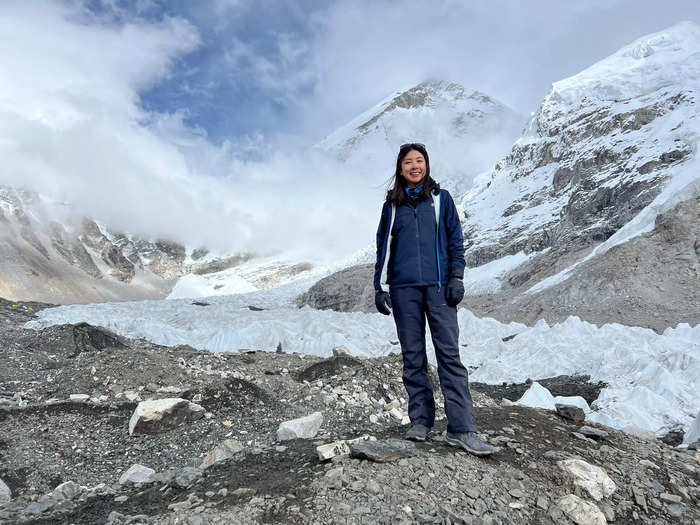
Some people dream of ascending Mount Everest their whole lives. I was never one of them.
Everest Base Camp is often regarded as one of the top treks in the Himalayas, if not the world, and I'd always marveled at photos of the breathtaking landscape. I'd also read stories about how life changing the trek is, but never thought I'd experience it myself.
But after finding out my sister was planning a trip to Everest Base Camp, I decided to join her and a group of eight friends. I knew the hike would be more mentally and physically challenging than anything I'd done before, but I was ready to push myself outside of my comfort zone.
I went on the trek with Explore Himalaya, a Nepalese tour company that has been leading trekkers across the Himalayas for over 25 years. Four guides and five porters accompanied my group of nine across the vast landscape of the Himalayas.
The views and rich local culture exceeded my expectations, but there were more than a few surprises along the way during the 11-day journey to base camp and back.
I thought I would feel nervous flying into what is considered the most dangerous airport in the world, but I actually felt really safe.
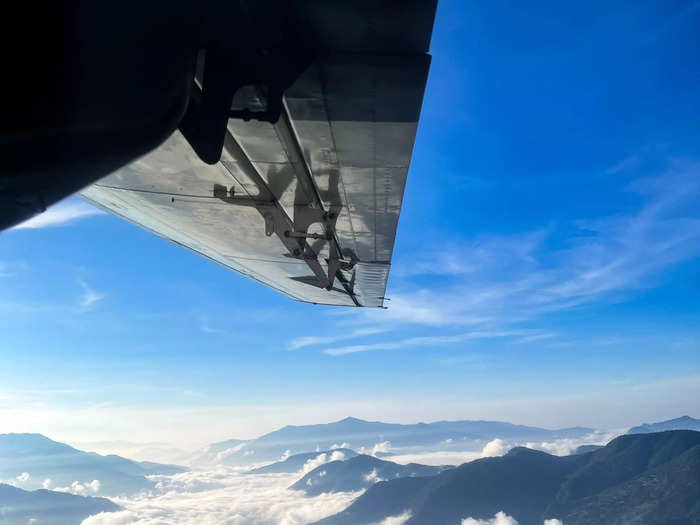
One of the things I was most worried about going into my trip was the flight to Tenzing-Hillary Airport in Lukla. Lukla is a small town nestled in the Himalayas that serves as the starting point for a trek to Everest, and it is accessible only by plane or by foot.
The Tenzing-Hillary Airport is considered one of the most dangerous airports to fly into in the world because it sits at an extremely high altitude of 9,383ft above sea level, and pilots must navigate through a mountainous region with unpredictable weather with only 1,729ft of runway to land.
There are typically 35-minute flights that fly from Kathmandu to Lukla. However, starting October 1st, 2022, all flights were rerouted to depart from Ramechhap, an airport four hours from Kathmandu by car, because of frequent delays at the Kathmandu airport, and rapidly changing weather.
I was pleased that my flight from Ramechhap in a small 20-person plane ended up being even smoother than flights I'd taken in 500-person planes, in my opinion. It definitely seemed a rarity to me based on videos and blog posts I'd read previously. Landing went seamlessly and I stepped off the plane to crowds of locals who came out to welcome us.
I was also surprised by how efficiently these flights operated. During windows of good weather, the planes fly back and forth between Ramechhap and Lukla nonstop. As soon as one landed, I saw ground crews run up to refuel it while passengers deplaned. Immediately after, the next group of passengers would be quickly ushered onboard. Generally, the planes were able to land and takeoff again in the span of 10 minutes.
On my return flight from Lukla to Ramechhap, I did experience the rough airs I heard about. Even though the skies were clear and sunny, we had bad turbulence as we flew close to the mountains. Because I was sitting at the front of the plane, I could hear automated warnings coming from the cockpit saying "Pull up!" I was glad this experience came at the end of my trip instead of the beginning.
I expected the trip to Everest be more expensive and time consuming to plan than it was. Going with a group made it really easy.
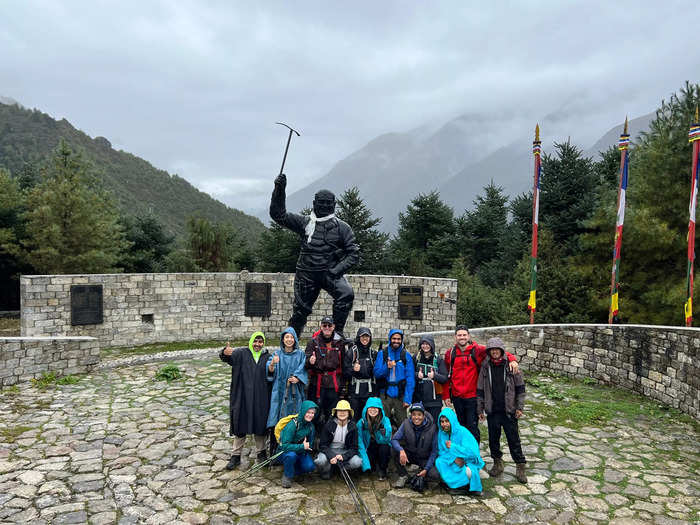
You don't have to be an elite athlete to visit Mount Everest, and many tour companies make it easy for most anyone to visit.
In fact, the 130-kilometer-long trek through the Himalayas to Everest Base Camp brings in about 40,000 people a year.
Because I went on this trek with a tour company, I didn't have to do any planning on my own. The package I booked included accommodations for 15 nights, including three nights at the four-star Aloft Hotel in Kathmandu, three meals a day, national park fees, porter service, 11 nights in tea houses on the trek, a return flight from Rammechhap to Lukla, and a sightseeing tour of religious landmarks in Kathmandu.
Explore Himalaya handled all of the bookings aside from my flight from New York to Kathmandu. Everytime we stopped for lunch or arrived at a tea house in the afternoon, there was a table reserved for my group. I realized this was a huge benefit when I learned some of the tea houses could be very crowded, and didn't always have rooms available for late arrivals.
We received a discount on the trek for booking as a group, so it ended up costing $1,330 per person for a group of nine. I did pay an additional $3 a night to rent a sleeping bag from Explore Himalaya, and I also had to bring my own hiking poles. But I thought the price was worth it considering it covered such a lengthy period of time and I didn't have to make my own bookings or do any of the planning.
I thought the tea houses we stayed in were more luxurious than I expected them to be.
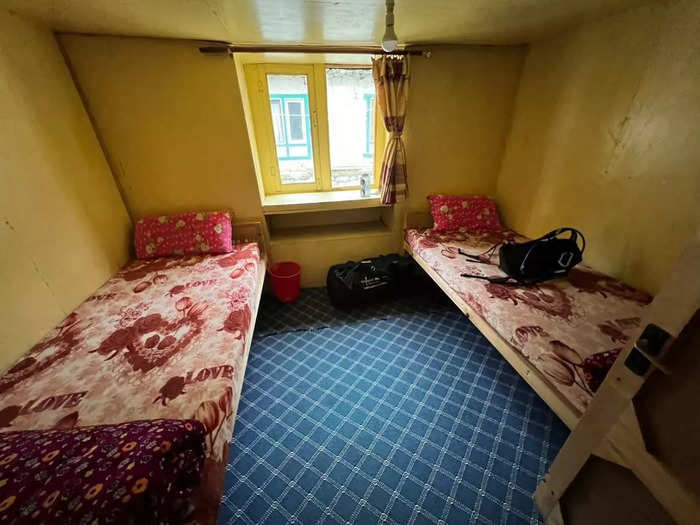
I'm not a big fan of camping so I was especially ready to join the trip when I learned we'd be staying in tea houses, which are small hotels run by locals. These tea houses are where hikers can lodge every night on their way up to Everest Base Camp.
I spent each night of our hike in one, and thought they would be bare bones with just four walls and a bed. However, I was surprised to find that many of the tea houses, especially below 5,000 meters elevation, came with unexpected luxuries like attached private bathrooms.
Additionally, most of the tea houses provided comfortable blankets, snacks or supplies for purchase, and hot showers.
Though at higher elevations above 5,000 meters, I noticed that these amenities decreased significantly as it became harder for locals to transport materials and access resources in the more remote mountainous regions.
At the end of each day, the tea houses fired up the dining room stoves using yak droppings for fuel. I discovered this source when I saw locals drying pieces of yak droppings in the sun and then scooping them into the stoves at night. Everyone staying at the tea house would then congregate to take advantage of the warmth, as there was no heating otherwise.
I thought the dining rooms were always lively and well stocked with food for purchase, and my group and I would sip hot lemon ginger honey tea and play card games until we retired for the night.
I was surprised that I had a good Wi-Fi connection and cell service for the majority of the trek.

When I arrived to hike Mount Everest, I was expecting to be completely disconnected. But I ended up having cell service or Wi-Fi on the majority of the trail.
Before leaving for the trek, I purchased an NCell SIM card in Kathmandu and my data worked for 75% of the trip. My guides used a different carrier called NTC, and their service was available for even more of the hike.
It only stopped working for me from days seven to 10 of the trek as we passed 4,000 meters. When it didn't, and in a few stops where none of the phone carriers worked, almost all of the tea houses and restaurants in those areas offered Wi-Fi for purchase.
The connection at those times was pretty spotty, so while I wasn't getting on video calls or streaming, I was at least able to send texts to family and friends back home to let them know that I was okay.
I didn't realize I'd become vegetarian during the hike.
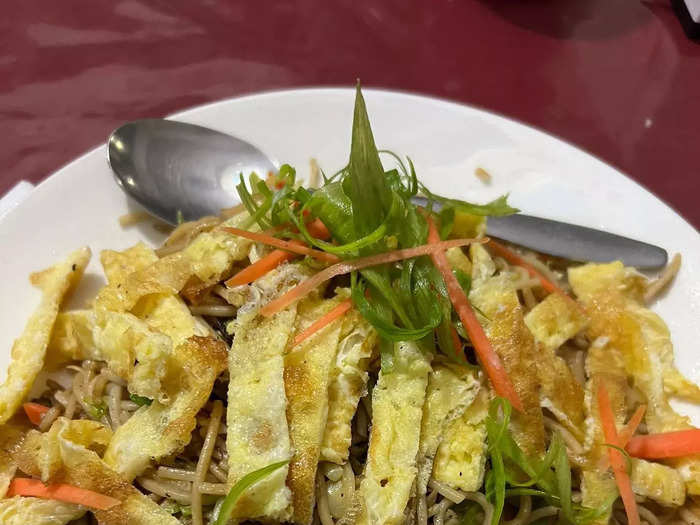
Before I left on the trek, a representative from Explore Himalaya debriefed my group on food safety standards in the mountains.
He told my group to stay away from meat in the mountains, where there are much lower standards for food safety. He told us a story about how he once was waiting for a helicopter to fly him into the mountains and saw crows picking at raw meat that was sitting on the ground waiting to be flown up into the mountains for hikers. He explained that this was the meat that would later be sold in the tea houses, and strongly recommended that we refrain from eating meat for the duration of the trek due to potential contamination.
Needless to say, no one in my group touched meat for the entire trek after hearing that story.
Luckily, all of the tea houses offered ample vegetarian options, from egg fried rice to veggie momos, dal bhat, and even the occasional pizza and ramen.
While I typically eat a lot of meat and never previously went more than a day or two without it, I was surprised to find that I didn't really crave meat at any point of the hike. While I'm still not ready to become a full vegetarian, I do find myself ordering meals without meat more frequently since returning from the hike.
I was not expecting the food portions to be so small given the difficulty of the trek.
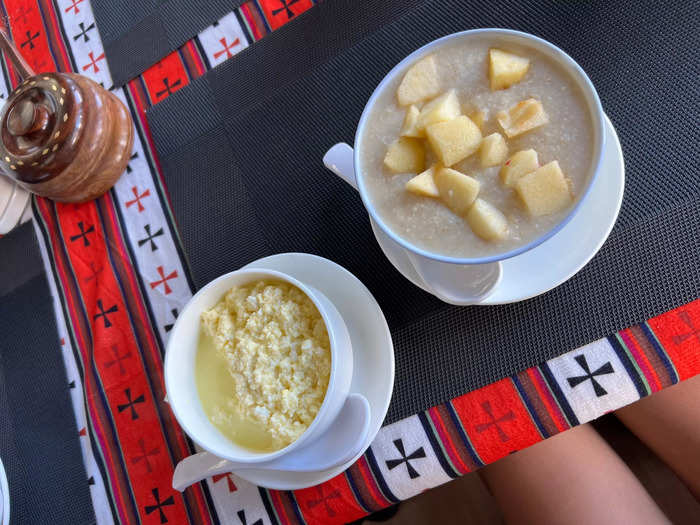
On the first day of the hike, I ordered a bowl of apple porridge and a side of scrambled eggs for breakfast, which I thought would be more than enough sustenance to get me through the first day of hiking.
When the porridge came out, it was about a third of the size of a typical bowl I'd order in the US, and after eating both the porridge and eggs, I was still hungry. I could have ordered more food, but my guide said we'd be stopping for lunch in a few hours so I decided to wait. But having smaller quantities of food than expected ended up being a recurring theme throughout the hike.
My group and I frequently ordered additional food on top of our meals, and I think our guides were both surprised and impressed by how much food and water we were able to consume. We, in turn, were surprised by how little food they were able to function off of given the strenuous amounts of hiking they did every day.
I definitely expected the portions to be bigger, considering that all of the guests staying at the tea houses were on the Everest Base Camp trek and hiking all day.
The only time I thought the portions were enough was at higher altitudes above 4,000 meters when people in my group started losing their appetite and feeling nausea due to altitude sickness.
The weather was warmer than I thought it would be and I didn't end up needing my heavy down jacket for any hikes.
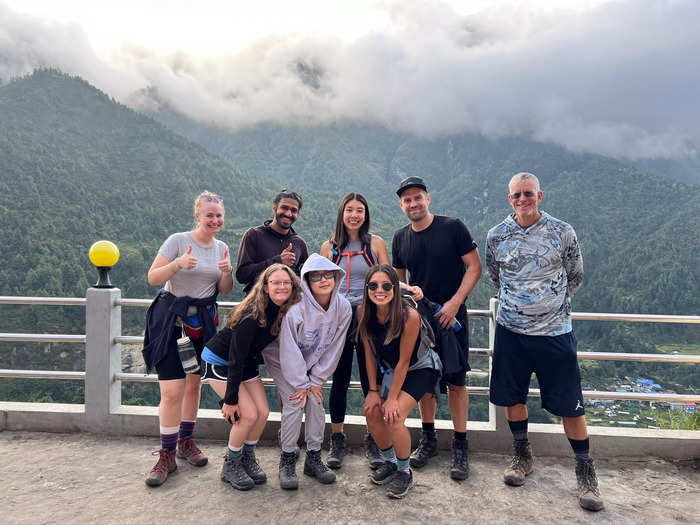
When researching what to pack for the hike, I read in multiple places that down jackets are absolutely essential because it can get to around 15 degrees Fahrenheit at higher altitudes.
I get cold pretty easily, so I played it safe and brought my thick ski jacket in addition to two base layers, a lighter down jacket, a windbreaker, a fleece zip-up, a thick vest, and a rain poncho.
Even in early October, I ended up only taking my ski jacket out when I was in tea houses above 5,000 meters. Even then, I thought it wasn't really necessary since I spent the majority of that time in warm dining rooms.
And at night, I would crawl straight into my sleeping bag padded with a liner and cover myself with warm blankets provided by the tea house, so I didn't need more than a base layer and light jacket to sleep.
The weather constantly fluctuated as well, between sun, rain, and occasional hail. Having the option to layer accordingly was a better strategy for me than wearing one heavy coat. This way, I could regulate my body temperature more easily.
One thing that ended up being essential was my full body rain poncho. I initially thought it would be unnecessary since I was hiking after the monsoon season, but brought it just in case. It ended up raining nonstop for about four out of the 11 days we hiked, with sporadic rain on the other days, as well.
Other people in my group brought waterproof rain jackets, but after a full day of hiking in rain, they were still drenched. My poncho was larger and extremely waterproof and saved me from being cold and uncomfortable on these long rainy hikes.
Since we arrived at the start of the trekking season, I expected less foot — and yak — traffic than we experienced.
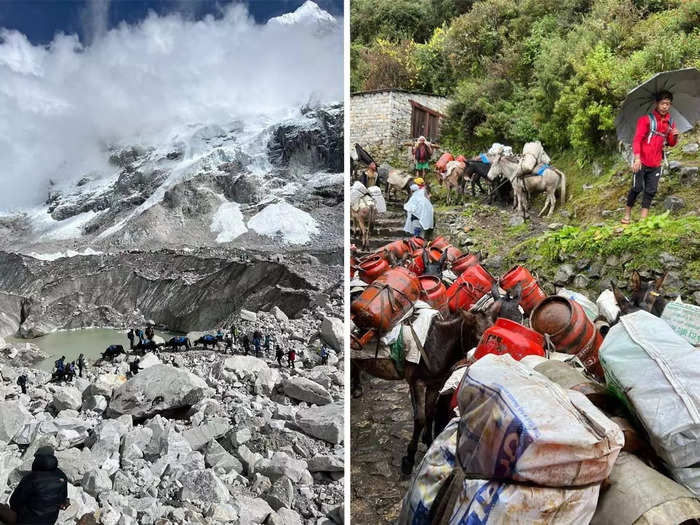
The hiking season for Everest Base Camp starts either in the spring before monsoon season, or after it ends around late September.
I started my hike on October 3, so I thought I'd be beating some of the crowds. However, my guides told me that the end of September and beginning of October are actually the busiest months to hike to base camp, while November and December are much lighter in terms of crowds.
When we started our trek, there were more open valleys and wide paths so I didn't think the foot traffic from other hikers was very noticeable.
But as I got closer to Everest Base Camp, I noticed that there were a number of narrow, rocky scrambles with few opportunities to pass other hikers. This slowed my group down as most of the hikers I waited behind were in groups, too, and we had to wait in long lines for our turn to pass.
There were also constantly large groups of yaks that would block off the entire trail. The locals depend on mules and yaks to carry essential supplies to remote mountain towns, so stopping for them became a daily practice. This was fine at lower altitudes, but I thought it was trickier at higher altitudes where we wanted to keep moving to stay warm.
The altitude affected everyone in my group differently, but we all got sick at some point.
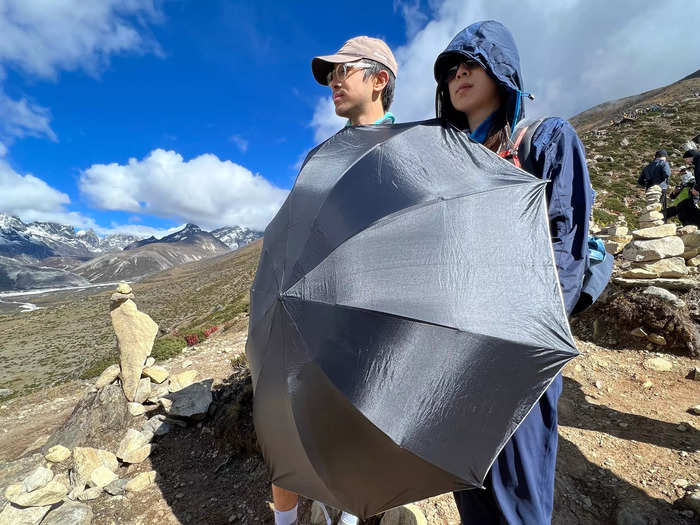
Sitting at 5,364 meters elevation, or 17,598 feet high, Everest Base Camp was the highest altitude I'd ever experienced. I'd never contended with altitude sickness prior to the trek.
I knew that headaches were common at higher elevations, but I didn't know much about other altitude-related symptoms such as nausea, loss of appetite, trouble sleeping, and more.
While I didn't have any headaches, I was hit with other symptoms that I later realized were attributed to altitude as we went higher up. I had severe bouts of nausea, and developed a runny nose, a cough, and generally felt unwell. I thought I caught a cold, or even a mild flu.
Other people in my group also suffered from various gastrointestinal issues, as well as loss of appetite, difficulty sleeping, and flu-like symptoms. I figured we all caught the same bug, but our guides told us that these symptoms were due to the altitude.
As soon as we started descending, my ailments disappeared almost as fast as they'd started, and I realized my guides were right.
I was surprised by how simultaneously humbling and empowering the mountains are.
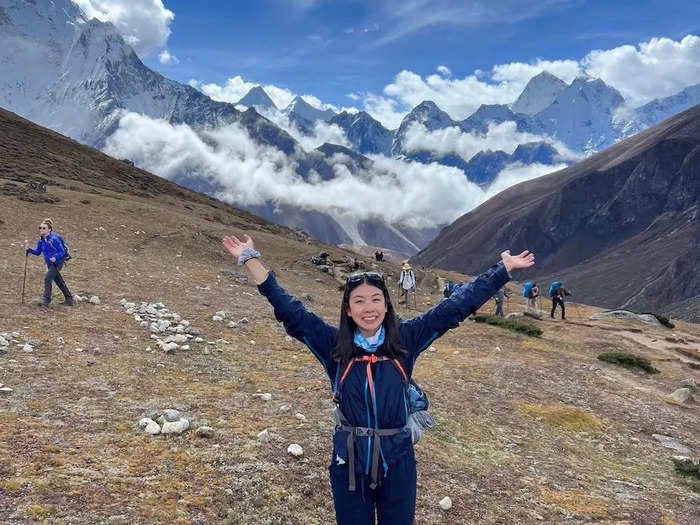
Trekking through the Himalayas was a powerful experience for me.
Being surrounded by panoramic views of the tallest peaks in the world and getting closer and closer to the top of the world every day was incredible. It became hard for me to verbalize how awestruck and accomplished I felt.
I also learned an important lesson: you can be the most prepared mountaineer in the world, but the mountain always has the last word.
During the trek, I heard firsthand about all the loss that happens in the Himalayas. Between our head guide Bal losing a friend to an avalanche on Manaslu the second day of our hike, to meeting someone who'd spoken with the late Hilaree Nelson's partner right after she went missing from an avalanche, I realized that despite being prepared, capable, and experienced, the mountain needs to be taken seriously and anything can happen.
In fact, almost 1 in 3 people die summiting the world's most dangerous 8,000 meter-high peaks, even when they're fully prepared.
It was a deeply humbling moment.
Finally, I didn't think I'd develop such strong friendships with my guides.
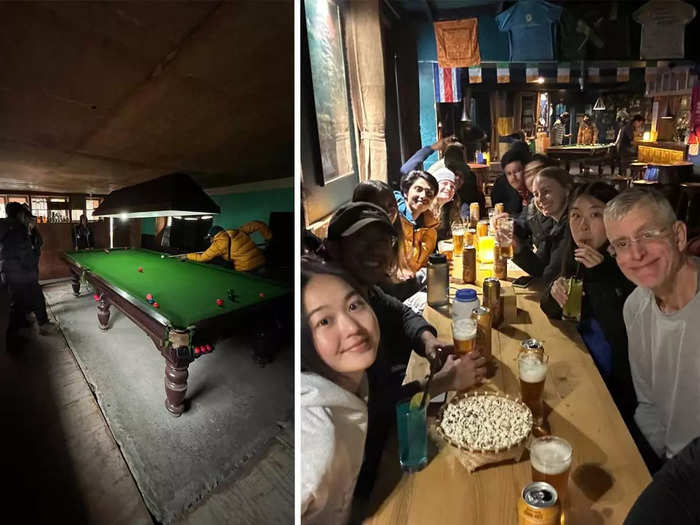
Four guides accompanied my group on the trek: Bal, our head guide; Raju, Bipin, and Jenis.
Bal and Raju were local to the Khumbu Valley in the Everest region and were the main guides for my group. They both have been guides for many years, first starting as porters before advancing to become guides.
Explore Himalaya also sent Bipin and Jenis, who grew up closer to Kathmandu, to join my group as content creators.
At the beginning of the trek, I thought all of the guides were generally quieter and focused mostly on making sure everyone in the group was safe.
But as the days went on, we formed a mutual trust and bond. We learned about each other, played cards, and shared stories every evening.
Despite some language barriers and cultural differences, we were able to genuinely enjoy spending time with each other and I learned a few local Nepali words, too.
On our way back down to Lukla, we made a few stops in some of the larger towns, such as Namche Bazaar, to play snooker — a game similar to pool — sing karaoke, and drink at the bars together.
We bonded so much that back in Kathmandu, my group decided to meet back up with our guides and even got matching tattoos of mountains and the Everest Base Camp elevation with one of them.
The guides are the main reason why Nepal feels like home to me now, and I'll definitely be back in the Himalayas for more trekking with them one day.
Popular Right Now
Popular Keywords
Advertisement